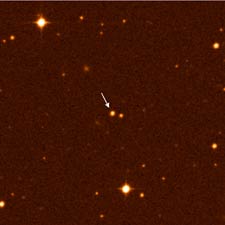
This 16th-magnitude star in Phoenix contains the lowest metal content of any giant star known. It has less than 1/200,000 the metallicity of the Sun and is most likely a second-generation star.
Courtesy European Southern Observatory.
Details aside, the story is simple. The universe began with the Big Bang. From this event came two elements: hydrogen and helium. The first stars ever — the so-called Population III stars — formed from these primordial gases and shone brightly in the early universe. Those stars eventually died, some as supernovae, and in the process released elements heavier than helium. These new elements, known in astronomical circles as "metals," were incorporated into the second generation of stars, which in turn lived, exploded, and produced more metals. Some 9 billion years after the Big Bang our Sun formed, and along with its hydrogen and helium, inside it are several generations of supernova-produced metals.
A long-sought astronomical Holy Grail is the discovery of any still-living Population III stars. Their interiors would contain the most pristine Big Bang material known. While that discovery remains elusive, astronomers have uncovered the next best thing: the most metal-poor star known — a telltale second-generation star.
Astronomers use the Sun as a baseline for metallicity and base their measurements on a logarithmic scale. An iron/hydrogen ratio ([Fe/H]) of zero is solar; negative values represent metal-poor stars, positive values metal-rich ones.
In this case a team of astronomers led by Norbert Christlieb (University of Uppsala, Sweden) uncovered a 16th-magnitude giant star in Phoenix known as HE0107—5240. Its Fe/H ratio is –5.3, corresponding to a metallicity 1/200,000 of the Sun's. The previous record holder for giant stars has 20 times more metal content.
"This is the oldest living star that we can study," says co-author Timothy C. Beers (Michigan State University). "A –5.3 star may be the first true second-generation star." It is so old, there simply wasn't enough time to make many stars yet. "It must have formed directly after the first generation."
Interestingly enough, scientists had all but dismissed the hope of finding Population III stars because no objects with a metallicity less than 1/10,000th solar had been detected for decades. It turns out that the astronomers simply hadn't looked deep enough. The star in Phoenix was identified on the more-sensitive Hamburg/European Southern Observatory objective-prism survey (HES), which probed almost 10 times the volume previous searches had.
Follow-up studies were made with instruments across the globe, from Siding Spring in Australia to Kitt Peak in Arizona. Those observations winnowed away all but the most extreme low-metal stars, which were then observed with larger telescopes such as the 8.2-meter Very Large Telescope (VLT) in Chile that was used in this study.
"Clearly, the existence of at least one example of a star with an iron abundance as low as [Fe/H] = –5.3 provides evidence that the limiting metallicity. . . may not yet have been reached," write Christlieb and his colleagues in the October 31st Nature.
Only about 25 percent of the 8,000 suspected low-metallicity stars in the HES survey have been followed up on. The search for the Grail will continue.
 0
0
Comments
You must be logged in to post a comment.